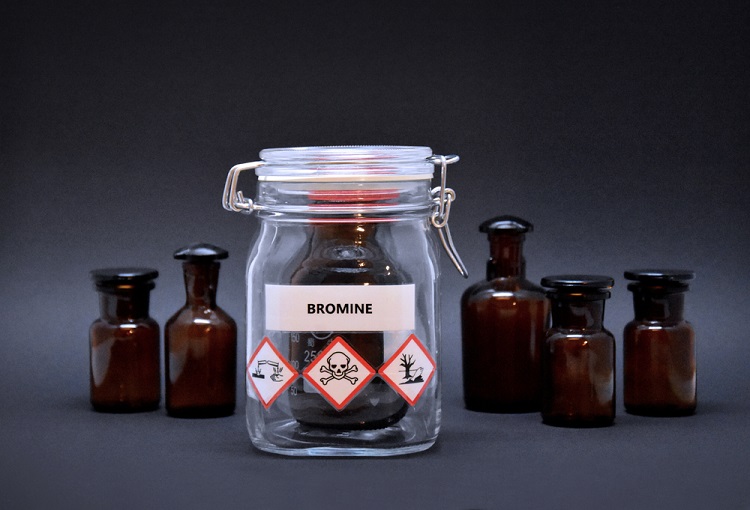
Bromine is a chemical element which has the atomic number 35 and symbol Br. It belongs to the group 17 of periodic table. It is a fuming red-brown liquid at room temperature with a suffocating odor, it becomes orange colored when vaporized. It is the third elements in halogen group, below fluorine and chlorine. Read more to find out more about the Bromine
It is usually found as bromide in seawater or in the form of ionic compounds in minerals found in seawater. In nature, it can be found as free element but that only occurs when volcanic gases react with sea water. Most of the bromine extracted from seawater and brines, but sometimes also from bromide-rich rare minerals.
It is used as an oxidizing agent, fire retardant and disinfectant. The most common use is as a precursor to fumigants, flame retardants and well drilling fluids.
Bromine is a chemical element with the symbol Br and atomic number 35. It is the third-lightest halogen, and is a fuming red-brown liquid at room temperature that evaporates readily to form a similarly coloured gas. Its properties are thus intermediate between those of chlorine and iodine. Isolated independently by two chemists, Carl Jacob Löwig (in 1825) and Antoine Balard (in 1826), its name was derived from the Ancient Greek βρῶμος (“stench”), referencing its sharp and disagreeable smell. The resulting substance resembles elemental iodine, and dissolves in water as bromine does. However, it is still somewhat similar to the two remaining elements in group 17 (the halogens). Elemental bromine is more reactive than iodine and chlorine.
Bromine is not found free in nature, but occurs only as a dissolved component of seawater, about 65 parts per million (equal to 0.0065%), or about 1.2 ounces per ton of seawater. This concentration is equivalent to 0.05 percent by weight of bromide ions in seawater (1 part per 1800). Get detailed information about various types of compounds and elements, on this website: www.bebegogo.com
Bromine is a chemical element with symbol Br and atomic number 35. It is the third-lightest halogen, and is a fuming red-brown liquid at room temperature that evaporates readily to form a similarly coloured gas. Its properties are thus intermediate between those of chlorine and iodine. Isolated independently by two chemists, Carl Jacob Löwig and Antoine Jerome Balard, its name was derived from the Ancient Greek βρῶμος (“stench”), referring to its sharp and disagreeable smell.
Elemental bromine is very reactive and thus does not occur free in nature, but in colourless soluble crystalline mineral salts, analogous to table salt. While it is rather rare in the Earth’s crust, the high solubility of the bromide ion (Br−) has caused its accumulation in the oceans. Commercially the element is easily extracted from brine pools, mostly in the United States, Israel, and China. The mass of bromine in the oceans is about one three-hundredth that of chlorine. At high temperatures, organobromine compounds readily convert to free bromine atoms. This effect makes organobromine compounds useful as fire retardants. Get detailed information about the best educational activities, on this website: www.chronicules.com
Different Types Of Bearings
November 27, 2022Interesting Facts about Kissing an Asian Woman
February 22, 2020
Leave a reply Cancel reply
You must be logged in to post a comment.
Why Gucci Crocs Are the Ultimate Trendy Footwear
April 22, 2022How To Choose The Right Baby Bag For Travelling
November 27, 2022Some Modern Interior Design Tricks To Transform Your Home
November 27, 2022




